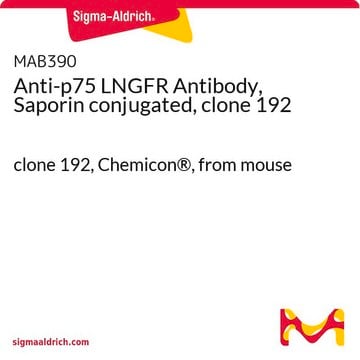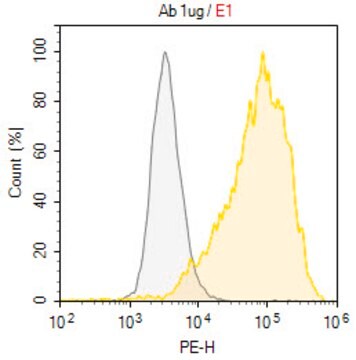MAB365
Anti-Nerve Growth Factor Receptor Antibody, extracellular, clone 192-IgG
clone 192-IgG, Chemicon®, from mouse
Sinônimo(s):
CD271 antigen, Low affinity neurotrophin receptor p75NTR, Low-affinity nerve growth factor receptor, NGF receptor, low affinity nerve growth factor receptor, nerve growth factor receptor, nerve growth factor receptor (TNFR superfamily, member 16), p75 IC
About This Item
Produtos recomendados
fonte biológica
mouse
Nível de qualidade
forma do anticorpo
purified antibody
tipo de produto de anticorpo
primary antibodies
clone
192-IgG, monoclonal
reatividade de espécies
rat
fabricante/nome comercial
Chemicon®
técnica(s)
immunocytochemistry: suitable
immunohistochemistry: suitable
immunoprecipitation (IP): suitable
western blot: suitable
Isotipo
IgG1
nº de adesão NCBI
nº de adesão UniProt
Condições de expedição
wet ice
modificação pós-traducional do alvo
unmodified
Informações sobre genes
human ... NGFR(4804)
Descrição geral
Especificidade
Imunogênio
Aplicação
Neuroscience
Neurochemistry & Neurotrophins
1-5 µg/mL (Non-reducing conditions only) was used on a previous lot.
Inhitibition Assay:
Inhibition on NGF binding {Chandler, 1984}.
Immunoprecipitation:
5 µg/mL, 0.5% triton X-100 buffer; PC12 positive control was used on a previous lot.
Immunohistochemistry:
1-5 µg/mL on rat spinal chord, of a previous lot was used. Other fixatives and methods can also be used.
Qualidade
1-5 µg/mL on rat , of a previous lot, (spinal chord, see protocol below); other fixatives and methods can also be used.
Descrição-alvo
Ligação
forma física
Armazenamento e estabilidade
Nota de análise
Western Blot: NGF-differentiated PC12 cell lysate.
Immunohistochemistry: Rat brain tissue.
Outras notas
Informações legais
Exoneração de responsabilidade
Not finding the right product?
Try our Ferramenta de seleção de produtos.
Código de classe de armazenamento
10 - Combustible liquids
Classe de risco de água (WGK)
WGK 2
Certificados de análise (COA)
Busque Certificados de análise (COA) digitando o Número do Lote do produto. Os números de lote e remessa podem ser encontrados no rótulo de um produto após a palavra “Lot” ou “Batch”.
Já possui este produto?
Encontre a documentação dos produtos que você adquiriu recentemente na biblioteca de documentos.
Nossa equipe de cientistas tem experiência em todas as áreas de pesquisa, incluindo Life Sciences, ciência de materiais, síntese química, cromatografia, química analítica e muitas outras.
Entre em contato com a assistência técnica








